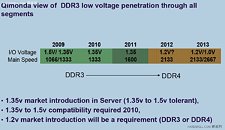- Joined
- Oct 9, 2007
- Messages
- 47,878 (7.38/day)
- Location
- Dublin, Ireland
| System Name | RBMK-1000 |
|---|---|
| Processor | AMD Ryzen 7 5700G |
| Motherboard | Gigabyte B550 AORUS Elite V2 |
| Cooling | DeepCool Gammax L240 V2 |
| Memory | 2x 16GB DDR4-3200 |
| Video Card(s) | Galax RTX 4070 Ti EX |
| Storage | Samsung 990 1TB |
| Display(s) | BenQ 1440p 60 Hz 27-inch |
| Case | Corsair Carbide 100R |
| Audio Device(s) | ASUS SupremeFX S1220A |
| Power Supply | Cooler Master MWE Gold 650W |
| Mouse | ASUS ROG Strix Impact |
| Keyboard | Gamdias Hermes E2 |
| Software | Windows 11 Pro |
The transition between PC memory standards has always relied on changes in PC platforms for effectiveness. For example, the LGA 775 saw transition between two standards, the i915 MCH supported DDR and DDR2 memory, i925 onwards it became mandatory for people to use DDR2 memory as the platform required it. In came DDR3 and it became optional for users to choose it over DDR2. Even now, there is only a gradual transit between DDR2 and DDR3. With Nehalem however, it will become mandatory to use DDR3 memory, both with the LGA 1366 and LGA 1160 socket motherboards in either two or three channel configurations.
Qimonda has already chalked out plans for a smooth transition to DDR4 PC memory. According to Qimonda's development plan, DDR4 would be out by 2012. The memory standard will operate at (DDR) frequencies as high as 2,133 MHz at an approximate voltage of 1.2 V and by 2013, we could be seeing 2,667 MHz memory at 1.0 V, a phase during which there's a transition between the current DDR3 and future DDR4 PC memory standards.

View at TechPowerUp Main Site
Qimonda has already chalked out plans for a smooth transition to DDR4 PC memory. According to Qimonda's development plan, DDR4 would be out by 2012. The memory standard will operate at (DDR) frequencies as high as 2,133 MHz at an approximate voltage of 1.2 V and by 2013, we could be seeing 2,667 MHz memory at 1.0 V, a phase during which there's a transition between the current DDR3 and future DDR4 PC memory standards.

View at TechPowerUp Main Site

 Standard as in the general trend with performance PCs. Today 2x 1GB or 2x 2GB is the standard, gaming PCs aren't greatly helped by 8 GB as yet. With Bloomfield since it's 3 channels, it's going to be 3x 1GB, 3x 2GB (6 GB total), in the coming years 3x 4 GB (12 GB)....24GB....48GB....so on and so forth.
Standard as in the general trend with performance PCs. Today 2x 1GB or 2x 2GB is the standard, gaming PCs aren't greatly helped by 8 GB as yet. With Bloomfield since it's 3 channels, it's going to be 3x 1GB, 3x 2GB (6 GB total), in the coming years 3x 4 GB (12 GB)....24GB....48GB....so on and so forth.




